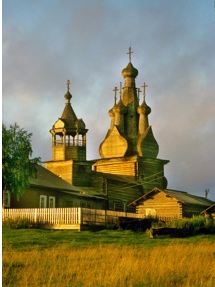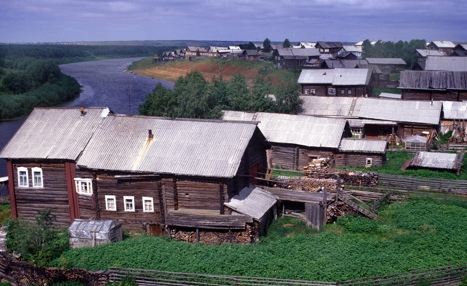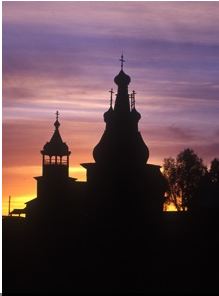 Hodegitria Church, Kizhma
Hodegitria Church, Kizhma The population of Kimzha varies between winter and summer: a couple of hundred in the winter, with a hundred or so more at various times in the summer, when relatives return to visit parents and grandparents. Its primary landmark is a church, dedicated in 1763 to the Hodigitria Icon of Mary.
For much of the year, Kimzha lies buried under severe winter conditions, stiff wind and treacherous snow drifts. At one time, there was limited scheduled transportation by water from Arkhangelsk, but that ceased to exist long ago. Today year-round transportation option by small plane is available from Arkhangelsk’s Vaskovo airport to Mezen, and from there by car (and boat) to Kimzha. During the winter there is a temporary road, or zimnik, but this is an exhausting, nerve-wracking route, whose usefulness has been curtailed in recent years by the ever earlier spring thaws. An year-round dirt road is nearing completion and will, in theory, open the way to Arkhangelsk.
 North panarama from the bell tower of the Hodegitria Church
North panarama from the bell tower of the Hodegitria Church Some residents are employed by the village administration, others live on the remnants of agriculture, and others have connections with the lumber plant in Kamenka. Although the former dairy kolkhoz, surrounded by rusting machinery, has withered, a large part of the dairy herd is now individually owned. The villagers are also sustained by the berries and mushrooms of the forest and the fish of the waterways. Locals are adept at growing and preserving much of their own food. Nonetheless, modern life requires certain amenities that are difficult to provide in this environment. With so many complications, the preservation of Kimzha—the buildings and the community—seems remarkable. While many former residents of Kimzha have left for work elsewhere, this emigration has helped Kimzha retain its age-old dimensions. And the arduous journey required to reach the village has also protected the integrity of its environment.
Yet these factors alone cannot explain the survival of Kimzha, when hundreds of other villages throughout the north have vanished. It appears that the physical existence of the church has played a major role in the village's endurance. With its tall, vertical form--over 27 meters (88 feet) high—the Hodigitria Church defines Kimzha from every perspective. The Russian north was rich in examples of log churches, such as the famous Transfiguration Church on Kizhi Island with its 22 domes, but the Kimzha church is the sole surviving example of its type—a high central tower and cupola closely flanked by four small cupolas. This style was created by a group of carpenters active only in this part of the north, near the Pinega River.
Begun in the early 18th century and consecrated in 1763, the Kimzha church has survived decades of neglect and the threat of accidental fire. In the 1870s, its stout logs were covered with plank siding, painted white with blue and green trim. At the same time, a bell tower was erected over the west porch. (An earlier bell tower stood separate from the church on the bank of the Kimzha River). Soviet restoration practice frowned on such 19th-century cladding, and in the 1980s some of the planks were removed. Lack of funds halted the restoration, and the church remained as a textbook display, half with plank siding and half without.
 Hodegitria Church, sunset
Hodegitria Church, sunset Despite its difficulties, Kimzha has, for the time being, found a delicate balance between past and present. A slowly increasing number of artists and specialists in the history of the north visit the village; tour companies talk of the possibility of building a small hotel. The opening of the new road might bring new resources, but also new problems. Without a source of local pride and spiritual values, conservation will be questionable. It all comes back to the church that stood at the center of the village. Russian can ill afford to lose such remarkable treasures.
William Brumfield
